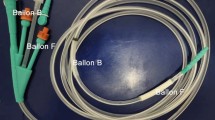Conclusion
1. Increasing the number of holes in intestinal decompression tubes increases their efficiency because such tubes do not depend upon a negative suction pressure at the end of the tube, but rather the intestinal contents are forced into the tube by an increase in the intra-luminal intestinal pressure.
2. Increasing the size of the holes increases the efficiency of the tubes by making it easier for intestinal contents to enter the tube and decreases the chances of plugging.
3. In cases of paralytic ileus, increasing the amount of mercury in the tube-head definitely increases the speed of intubation and appreciably reduces the percentage of failures.
Similar content being viewed by others
References
Miller T.G., and Abbott, W.O.: “Intestinal Intubation, a Practical Technic” Am. J. M. Sc., 187:595–599, 1934.
Harris, F.I.:: “New rapid method of intubation with Miller-Abbott tube” J.A.M.A. 125:784–785 1944.
Cantor, M.O.: “New simplified intestinal decompression tube” Amer. Jour. Surg., 72:137–142,1946.
Author information
Authors and Affiliations
Rights and permissions
About this article
Cite this article
Cantor, M.O. Physics in intestinal intubation. Amer. Jour. Dig. Dis. 17, 10–11 (1950). https://doi.org/10.1007/BF03002497
Received:
Issue Date:
DOI: https://doi.org/10.1007/BF03002497



